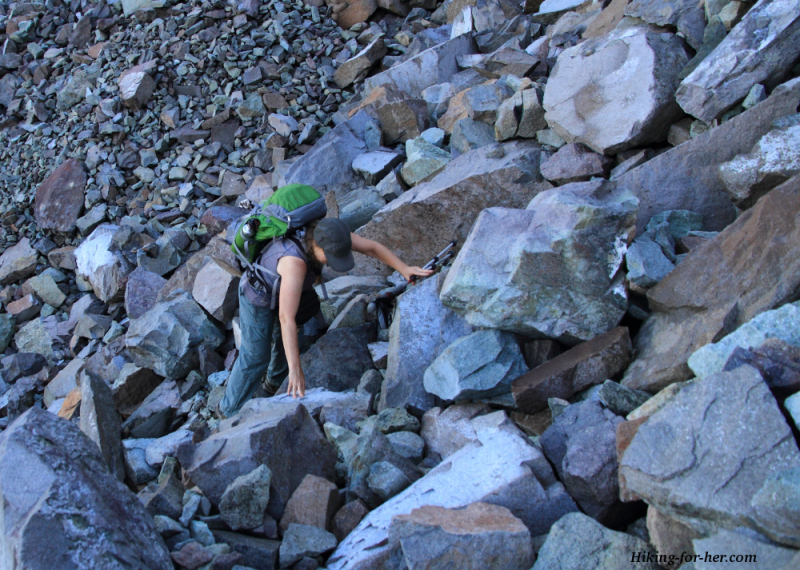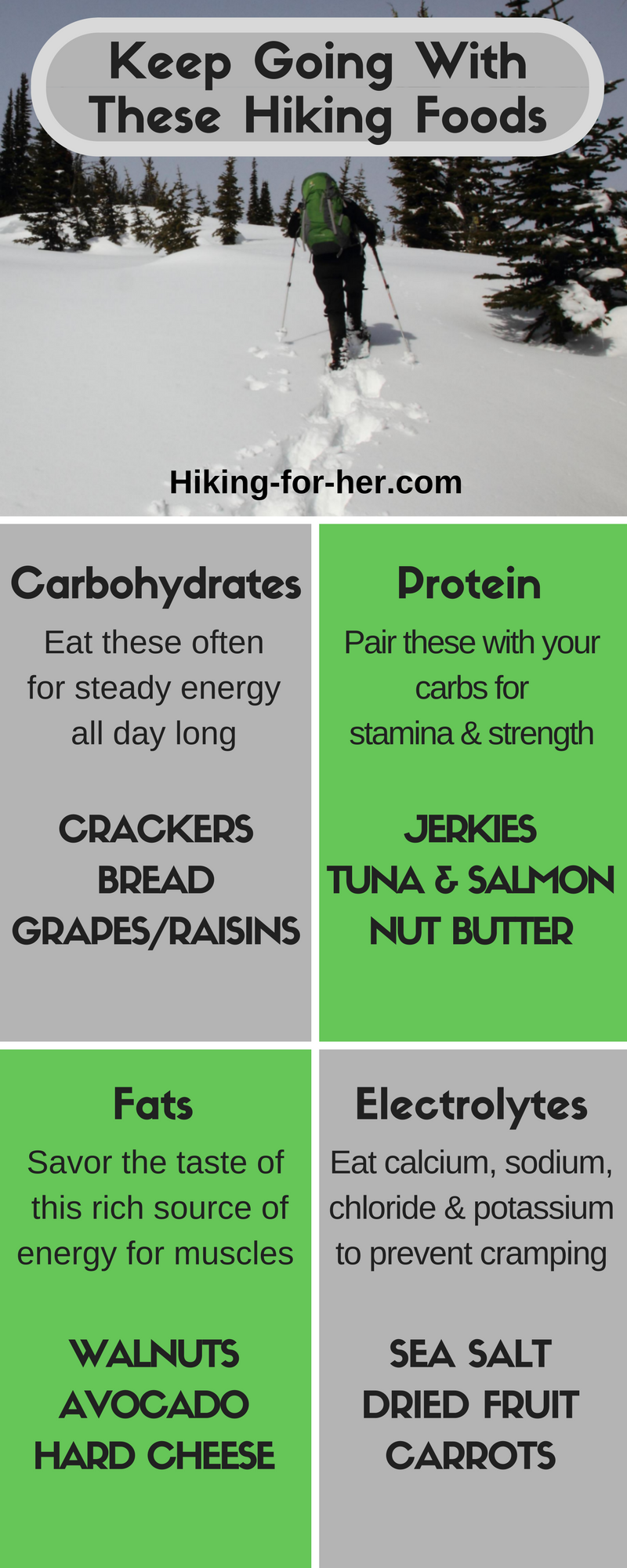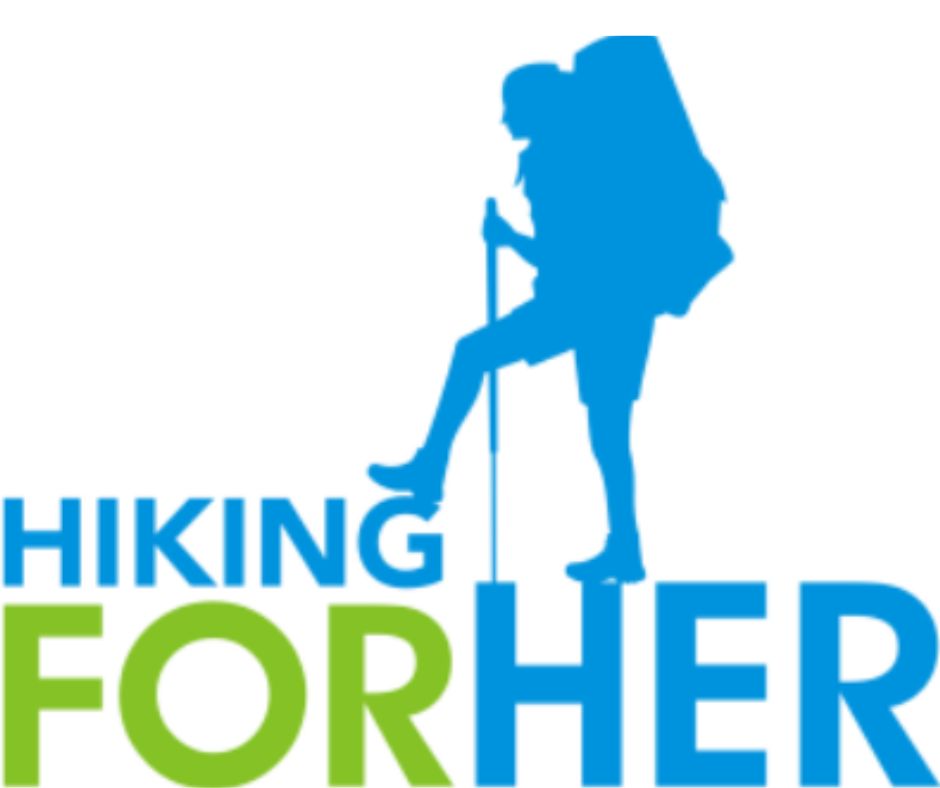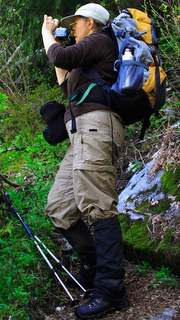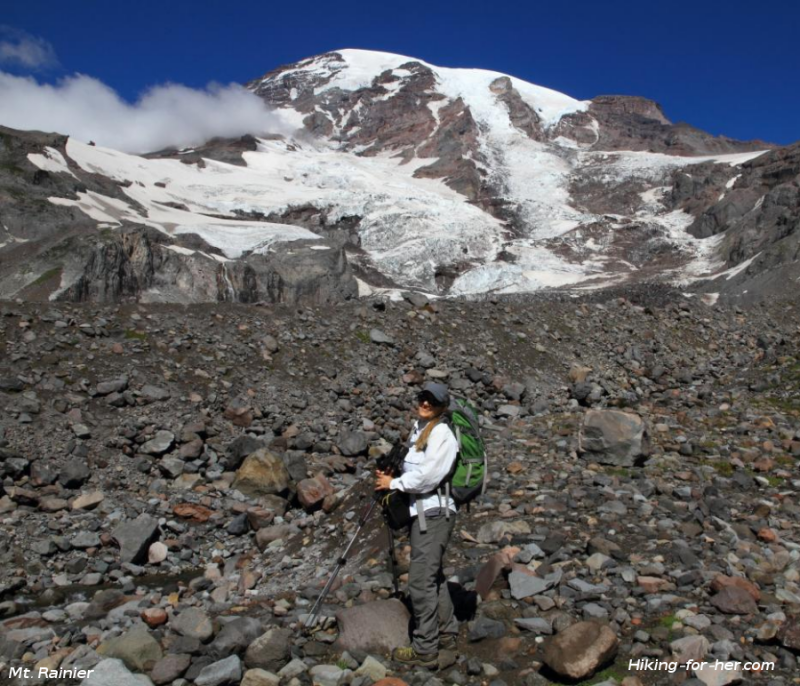Enjoy Happy Trails, the free monthly newsletter from Hiking For Her
Receive a free resource: "Hiking Layering System Explained"
Hiking Energy:
Can Sugar Be Your Friend?
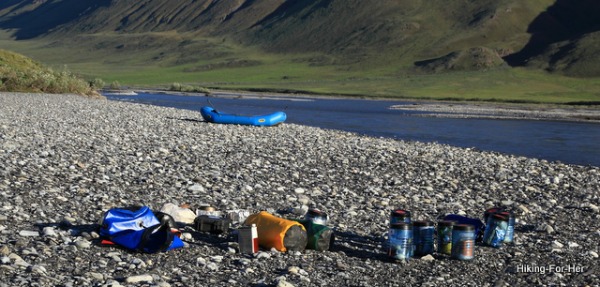 Hiking energy is just another way of saying lunch!
Hiking energy is just another way of saying lunch!By Diane Spicer
This information is written from the perspective of "typical" American eating patterns.
A keto diet, which deliberately eliminates carbohydrates from daily food consumption, is not addressed here.
Hiking energy depends on a steady flow of a sugar called glucose to your muscles, brain, heart and all points in between.
How to keep an abundance of energy flowing throughout your hiking day?
Try a little cellular thinking!
You derive energy from all nutrients in your diet, but it's the all important carbohydrates (glucose) which are the primary fuel source for your brain cells and all of your body tissues, including your red blood cells and hard working muscles which power you through your hike.
Here in the Pacific Northwest, it's not unusual to do double digit mileage and two or three thousand feet of elevation gain (and then loss, at the end of the trip) on a day hike lasting 8 hours.
And we won't even mention the boulder fields, talus slopes, and bushwhacking.
That's a lot of work!
And it calls for a lot of fuel.
So where do I turn?
To glucose!
Preferred hiking energy molecule: glucose
Glucose is the carbohydrate (fancy way to say "sugar molecule") which human cells use as fuel:
- 4 (kilo)calories per gram, if you want to get technical about it.
But it's not usually found by itself in our diets. It prefers to attach to other sugars.
Other sugars?
Lots of other sugars in your diet?
Yes, like fructose (the sweetest of Nature's sugars).
I'll bet you can tell which foods contain high levels of fructose, just by its name.
And you can toss in vegetables, too.
Other names for fructose include levulose or fruit sugar.
Maybe you've heard all the controversy about high fructose corn syrup and its negative health implications (childhood obesity and diabetes being among them).
- It's probably a good idea to limit your intake of HFCS until the science sorts itself out.
And there's another sugar called galactose, which joins with glucose to create lactose, or milk sugar.
Mother Nature gets fancy by combining these sugar molecules into other sugars.
For instance, maltose is a molecule composed of two glucose units.
Sucrose is one glucose molecule combined with one fructose molecule.
- It's sucrose that you taste in really sweet things, like honey, maple syrup, and fruits.
When you get right down to it, any form of sugar from Nature contains very few nutrients, but will release a standard amount of energy per unit.
So don't look to table sugar, honey, molasses, fruit, or "raw" sugar as a source of nutrients (such as fat, protein, fiber, vitamins, minerals, or electrolytes) - but do expect a ready source of energy for your cells on a hike.
If you've been taught to fear or avoid sugar, think again as a hiker!
Your cells need fast energy, and by fast I mean easily absorbed and delivered quickly to your organs.
Carbohydrates are a
hiker's best friend
Hiking energy can be derived from two types of carbohydrates (carbs): simple or complex.
- Simple carbs are built from single sugar molecules, and glucose would be a great example.
- Complex carbs are long chains of glucose molecules, implying that they store lots of energy. Ever heard of starch and glycogen? They are complex carbs because Nature stores glucose in those forms. Throw in a little fiber, too.
So a hiker can reach for these carbs in the form of trail snacks, backpacking meals, drinks....and it's a good idea to choose wisely.
Starches
Starchy foods include grains, tubers, and legumes.
If that's just mumbo jumbo to you, try this list:
- breads and cereals (wheat, rice, corn, oats, barley),
- root vegetables (potatoes, yams, carrots, beets),
- peas,
- beans,
- lentils.
Usually, hikers don't have trouble digesting starches. They act as a quick energy source and can be easily chomped on while moving.
If you ingest more carbs than you can use right now, you'll store it for later.
Too many stored carbs? You'll gain weight unless you're using them soon, as in a backpacking trip.
And then there's glycogen
Glycogen is a stored form of glucose in your liver and skeletal muscles.
Your body can break down glycogen into glucose & release it into your bloodstream quickly when you demand it during your hike.
As long as
you've built up some reserves by eating well the day before, and morning of, the hike.
And are paying attention to replenishing
your sources of hiking energy throughout your hiking trip. Hiking snacks!!!
More good news!
Your hard working liver can convert most of the fructose and galactose molecules you ingest into glucose.
This assures a constant stream of energy into your bloodstream, to be delivered to your hard working cells, regardless of which types of carbohydrates you are eating.
What does this mean for a hiker?
- No brain fuzz
- No slow starts
- No navigational errors
- No grumpiness due to low blood sugar
- No weak knees
- No "out of gas" feeling
Hiking energy, slow and steady. Such a deal!
To be a well rounded endurance athlete (that's you, hiker!), read this information about nutrition and athletic performance.
And to be a smart hiker, work with your body rather than against it, by paying close attention to a few things.
What's glycemic index got to do
with hiking energy?
First thing: defining glycemic index.
This is a measurement scale for various foods compared to pure glucose, in terms of their potential to raise blood glucose levels.
If you need FAST energy (a.k.a. glucose in your bloodstream), you choose high glycemic index valued foods.
- Mashed potatoes, candy bars, white bread or rice, pasta are the classics chosen by long distance hikers.
But beware! There's a price to be paid.
When you have lots of glucose in your bloodstream, your cells need a hormone called insulin in order to snag that lovely sugar (glucose) and take it inside, where it can be used to make energy molecules (ATP).
And sudden spikes in blood sugar levels ask the pancreas, which makes insulin, to work pretty hard.
Ever hear of a "sugar rush"?
Ever have one? If so, you know that the sudden spurt of energy feels great while you're powering up a hill, but it can leave you shaky and weak afterwards.
Crash and burn, on a cellular level...
Make a smarter choice
A much smarter choice would be to consume foods with lower glycemic index values:
- trail bars made of dried fruits and nuts and sweetened with dates
- high fiber whole grain crackers
- beans mashed up and spread on high fiber bread
- quinoa or other hearty grains
You still get the hiking energy, but you don't overtax your pancreas.
And over the long haul (affectionately known as your life time), you will enjoy protection against heart disease, type 2 diabetes, and certain types of cancer, in addition to reliable hiking energy.
One more piece of good news
Using carbohydrates for fuel spares the
break down of protein for fuel.
In other words, you get to keep your
hiking energy AND your skeletal muscles!
Here's a fact to chew on:
Americans eating a "typical" diet (Standard American Diet = SAD) consume too many simple sugars, which are added to foods as sweeteners and syrups in order to appeal to the in built drive for sweet things.
Take a stroll down a grocery store aisle and count up the array of cookies, cakes, candy, sweet drinks, and pies - low in fiber, high in "empty" calories because they supply energy but no nutrients.
If you consume lots of excess calories, you're going to store those simple sugars as excess fat - unless you're physically active at a high level every day.
- Which means backpacking!
If hiking for weight loss is your goal, pay particular attention to the calorie spread in your hiking trail snacks, but don't skimp on the carbohydrates as you enjoy the trail.
Lots of different ways to say sugar
I want you to be aware of all of the ways that sugar can creep into your food supply.
That leads to better decisions about how you're getting hiking energy from the lunch you pack for your day hike, or the meals you carry on a backpacking trip.
I challenge you to read the food labels on one week's worth of hiking food, and see how much "hidden" sugar you might be in for!
Here's a list of terms for simple sugars in the American diet.
*dextrose
*corn syrup (can be as high as 98% glucose)
*corn starch, or other starches added to food
*maltodextrin
*grape sugar
*brown sugar (99% sucrose - white sugar with coloring)
*confectioner's sugar/powdered sugar
*invert sugar (sucrose syrup is heated with acid, giving a smooth texture useful in creating the desired consistency of foods)
*levulose (just another way to say fructose, or fruit sugar)
*mannitol
*sorbitol
*turbinado sugar ("raw" sugar)
*xylitol
*molasses (least refined type of sucrose
*high fructose corn syrup: converted from glucose to fructose to provide a cheap, sweet ingredient.
That's a lot of different words for sugar!!
But now you know.
Alternative sweeteners any good for hikers?
Just a word about alternative sweeteners, namely:
- saccharin (Sweet n' Low)
- acesulfame-K (Sweet One)
- aspartame (Equal, NutraSweet)
- sucralose (Splenda)
Realize that these molecules give your food sweetness, but don't give you energy.
You'll have to get that through carbs (see above).
What about stevia?
Stevia is worth a mention here as a plant based sweetener and sugar substitute. Again, no energy value but stevia can satisfy a sweet tooth without spiking blood glucose levels.
- It's concentrated sweetness, so a little goes a long way.
- Some people report a weird after taste.
- So experiment with it to see if it's going to work as a food additive for your palate.
Become a label detective
Your head should be spinning by now. Lots of ways to sneak sugar into foods!
If you ever find yourself with some time on your hands in a grocery store or food mart, spend 15 minutes looking at food labels.
- Look at products which are not typically what you'd think of as sugar laden: catsup/ketchup or peanut butter, for instance.
- Take a good long look at how many calories are coming from sugar.
- A food label should give you "total carbohydrate" numbers, in grams, but should go beyond that to list fiber and sugars.
Then turn to sources of complex carbohydrates, and think about ways to get them into your backpack for hiking energy.
Don't be fooled by labels which promise you "wheat flour" - you want whole grain flour, from wheat or other grain sources.
Why?
Because you want fiber and vitamins from the whole grains, and you want the feeling of fullness which indicates that you will have a slow release of hiking energy for hours after you consume your morning bowl of oatmeal or your sandwich at lunch.
Hiking with dietary restrictions?
If you're a gluten free hiker, you'll have to work harder to get fiber and vitamins, because the rice, oat and other flours used to produce GF products are not enriched.
Trying to go organic?
- Here are some tips for hikers.
Or paleo?
So this challenge boils down to detective work.
- Become a label detective.
- It's somewhat of a pain at first, but it becomes addictive to watch for hidden sugars.
- And keep track of how you feel as you eliminate excess, processed sugars from your hiking diet.
Let's sum up hiking energy
OK, recap time.
To keep going on (or off) the hiking trail, hour after hour, your body needs fuel.
Carbohydrates give your body just what the name says: carbon, hydrogen, and oxygen atoms, used to generate cellular energy.
- Carbs are made by plants via photosynthesis, resulting in the lovely sugar molecules glucose, fructose, and galactose.
- Human biochemistry prefers glucose as a fuel source.
- Therefore, you
want glucose for hiking energy.
- The question is: which sources are best for a hiker?
You can go the "simple carbs" route, relying upon foods with high glycemic index values to flood your bloodstream with glucose: a "sugar high".
Or you can ingest "complex carbs", referring to the fact that they're harder to pull apart into glucose molecules and will be in the form of starch, glycogen, and fiber.
This results in a slower, more sustained release of hiking energy.
And on a long, tough hike, you'll need some of both. Fast energy to power up a hill, sustained energy to get the mileage done before sun down.
Every cell in your body uses glucose for energy. While you're hiking, you want to keep three particular cell types VERY happy:
1. Brain cells for navigation, route finding, remembering the lyrics of your favorite songs, and safe decision making.
2. Skeletal muscle cells, for strength, balance, endurance, and stamina.
3. Red blood cells, for oxygen transport to muscles so that you have a steady supply of energy being released, and to the brain (see above).
To answer our original question...
Yes, sugar can be your friend on a hiking trail. Just be smart about how you get your glucose.
So what can you eat for hiking energy?
Put lots of whole grains and cereals, fruits and vegetables into your hiking menu planning if you want sustained hiking energy and a peaceful gut.
In fact, every time you eat an oatmeal cookie as a trail snack, thank yourself for providing complex carbs!
Here's an additional resource for planning your hiking food needs, designed by me after many years of trail time.
My wish for you:
Hiking energy in abundance, to fuel your hiking adventures!
Home page > Best Hiking Tips >
How To Get Hiking Energy

